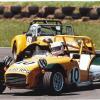I found the film of the race on youtube, Never saw it at the time as was elsewhere that day. Rindt runs out of fuel and pits on lap 76 and Hill shortly after. Both cars seem to be 10%short of the required fuel for the race. Now I can understand running out on the last lap, being aware of Chapman's detest of excess weight. But why so short on both cars?
British GP 1969
#1

Posted 08 December 2018 - 13:25
Advertisement
#2

Posted 08 December 2018 - 13:29
OTTOMH, weren't those ex-Tasman cars which Lotus pressed into service after Jochen and Graham had refused to drive the 63s? Maybe they'd been fitted with smaller tanks for the Tasman races?
#3

Posted 08 December 2018 - 14:17
It was the British GP so when a team determined fuel consumption in practice, it was unlikely that race conditions (atmospheric pressure and moisture) were identical.
Lotus also ran the 4WD 63 cars, eventually putting Hill into a borrowed Lotus 49B. Stretched resources lead to mistakes.
#4

Posted 08 December 2018 - 14:45
I think one of the 49Bs was borrowed/comandeered back from Jo Bonnier, who then drove the 63 that hadn't curried favour with the works drivers.
Sorry, that's not answering the question...
#5

Posted 08 December 2018 - 15:20
Hill's car 49/R8 was borrowed back of Bonnier. Rindt's car 49/R6 was used in the previous and following GPs and had been Hill's car for the last 4 GPs of 68. Thanks to DCN.
#6

Posted 08 December 2018 - 19:14
If they ran out that early did they potentially miss a churn out of the allocation for each car?
I imagine even having the mixture at fully rich (as with Brabham at Brands in 1970) would have led to them running short closer to the finish.
Chapman was well known to be pretty optimistic with his fuel calculations and determined to be as close to the limit as possible, Lotus lost quite a few likely wins from running dry close to the end of the race
#7

Posted 08 December 2018 - 20:02
OTTOMH, weren't those ex-Tasman cars which Lotus pressed into service after Jochen and Graham had refused to drive the 63s? Maybe they'd been fitted with smaller tanks for the Tasman races?
Any problems due to forgetting to replace fuel tanks would have become apparent before Silverstone.
Hill used R8 in the Tasman series. This was later driven by Attwood at Monaco and Bonnier in Germany.
Rindt drove R9 at Pukekohe and Levin (briefly). That car was shipped back to UK for repair and used by Rindt again in Spain. Written off.
Rindt drove R10 in Tasman races from Wigram onwards. This was driven by Hill from Monaco GP.
R6 the chassis used by Rindt at Silverstone was the car used by Hill in Spain.
Chassis numbers per ORC. The NZ author Vercoe wrote that the initial Tasman chassis were R3 and R5. As R3 was owned by John Love at the time that is most unlikely.
#8

Posted 08 December 2018 - 21:06
I'm sure I've read that the mechanics were told to put some much fuel in by Chapman. They knew that that amount would be marginal, so they sometimes used to add another gallon, the so- called 'Mechanics Gallon'. I'm sure I've read that that is what happened at this race...and they still ran out of fuel. Where's Michael Oliver when you need him..?
#9

Posted 08 December 2018 - 22:05
He did quote one of the mechanics, Billy Cowe, talking about the regular showdowns with Chapman over how much fuel to put in and suggesting that Silverstone might have been the one race where they stopped arguing and actually put in the amount of fuel prescribed by Colin.
My favourite ‘mechanic’s gallon’ story in Michael’s book was the 1967 Italian GP where Clark famously ran low on fuel in the last couple of laps:
... Clark’s mechanic Allan McCall ... tells a familiar tale about Chapman’s obsession with the amount of fuel put in his cars: ‘Chapman did the fuel calculation and decided that we only needed 31 gallons or something crazy like that! Everybody thought ‘**** off!’ So Dick Scammell took me to one side and muttered “Put 33 in it” and I’d done my own calculations and I put 36 in it! I think we were about five or six gallons above what Chapman had calculated for that particular weekend. People say we had a fuel pump failure - that’s bullshit! We simply ran out of fuel because Chapman had screwed up chronically with his calculations ...
‘After the race he was shouting “Who put the fuel in, how much fuel did you put in the car?” I think Scammell spoke up and said “Actually Mr Chapman, you said 31 gallons and I told Allan to put 33 in it ...” and I said “... and I put 36 in it!” and I got this enormous lecture about not doing what I was ****ing supposed to do. He was saying “Don’t you EVER do that again. If I tell you to put 31 gallons in it ... blah, blah, blah.” But that was the wonder of Chapman: the man was brilliant but, now and again, he had also to realise that some of us had brains. We could calculate - we went to school ourselves you know!’
#10

Posted 08 December 2018 - 22:34
In his Lotus 49 ‘bible’ Michael Oliver was non-committal about why all three 49s (including Siffert) ran short of fuel at Silverstone, suggesting it might have been down to not putting enough fuel in (‘mechanic’s gallon’ notwithstanding) or that the fuel system didn’t pick up the last few gallons in the tanks. He noted that the fuel system was redesigned later in the year to improve fuel pickup.
Siffert raced for Rob Walker, no stranger to the car or racing. I would think his mechanics would make their own consumption calculations. Yet he still ran out of fuel. This should point towards a pickup problem that affected all 49s of similar configuration. And the system was redesigned later in the year...
#11

Posted 08 December 2018 - 23:29
#12

Posted 09 December 2018 - 05:35
I'm sure I've read that the mechanics were told to put some much fuel in by Chapman. They knew that that amount would be marginal, so they sometimes used to add another gallon, the so- called 'Mechanics Gallon'. I'm sure I've read that that is what happened at this race...and they still ran out of fuel. Where's Michael Oliver when you need him..?
Isn't there a story about this in "Tales from the Toolbox" ? where both sides (Chapman/crew) out-guessed each other and caused a problem. I can't remember if that related specifically to Silverstone though.
#13

Posted 09 December 2018 - 10:06
#14

Posted 09 December 2018 - 11:57
The mechanic's Gallon is coved in Michael Oliver's book Tales from the Toolbox.
#15

Posted 09 December 2018 - 22:52
Could it have had something to do with the centrifugal forces generated by the circuits high speed, predominately right hand corners?
#16

Posted 10 December 2018 - 20:28
They would have been the same when they did their testing...
And surely testing should have included running down to low levels?
#17

Posted 11 December 2018 - 13:50
Siffert raced for Rob Walker, no stranger to the car or racing. I would think his mechanics would make their own consumption calculations. Yet he still ran out of fuel. This should point towards a pickup problem that affected all 49s of similar configuration. And the system was redesigned later in the year...
Perhaps British weather confused fuel consumption calculations.
Could it have had something to do with the centrifugal forces generated by the circuits high speed, predominately right hand corners?
The previous race was at Zandvoort where the cars were running clockwise at high speed for much of the time. If there had been a fuel pick up problem, then the "mechanic's gallon" solution would have fixed it at Silverstone.
Somebody at Lotus made a mistake wth the fuel calculations or misunderstood the difference a wee turn on the fuel metering unit would make. The Lotus mechanic crew at the race were expected to support Team Lotus 49Bs and almost unraceable 63s, and to provide ad hoc help to privateers. Chapman and the design team were trying to make the Lotus 63 work, whilst designing a conceptually different F1 car. It was almost inevitable that Team Lotus made errors.
I'd like to know more about what happened at RWR at the time.


















